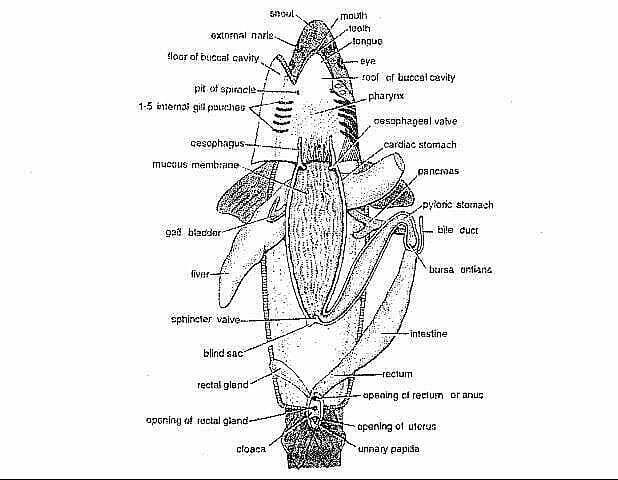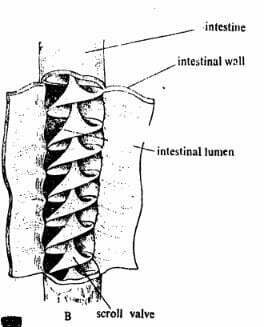In this article about the Scoliodon, we will learn about the digestive system of Scoliodon with a diagram. Scoliodon is a cartilaginous fish that belongs to the class Chondrichthyes.
What is Digestive System?
The digestive system is a physiological system by which an animal turns complex food into absorbable simple food in order to keep functioning the body.
Digestive System of Scoliodon

fig: Digestive system of Scoliodon.
The entire digestive system of Scoliodon is divided into two major parts. They are 1. Alimentary canal, and 2. Digestive glands.
1. Alimentary Canal
- The alimentary canal starts from the mouth and ends at the anus.
- The digestive system of Scoliodon is complete because it has both mouth and anus.
- The alimentary canal is longer than the body of the dogfish.
- It consists of the mouth, buccal cavity, pharynx, oesophagus, stomach, intestine, and anus.
A. Mouth
-
-
- The alimentary canal starts from here.
- It is a wide crescentic opening.
- It is present on the ventral side of the head.
- It is bounded by upper and lower lips.
-
B. Buccal Cavity
-
-
- The mouth opens into the buccal cavity.
- It is spacious, dorso-ventrally flattened, and lined with mucous membrane.
- Jaws are present in the buccal cavity.
- Teeth are present but they are not attached to the jaws. Teeth are embedded in the skin.
- Teeth are homodont type, which means all the teeth are similar in shape.
- Teeth are sharply pointed and directed backward. They are arranged in several rows.
- Teeth can be replaced several times if lost or destroyed. That’s why their teeth are polyphyodont.
- The tongue is present on the floor of the buccal cavity.
- The tongue of Scoliodon is non-muscular and non-granular.
-
C. Pharynx
-
-
- The buccal cavity leads into the pharynx.
- It is lined by endoderm.
- On either side of the pharynx, there present internal openings of the spiracles and five branchial clefts.
- The mucous membrane of the pharyngeal wall bears numerous dermal denticles.
-
D. Oesophagus
-
-
- The pharynx leads into the oesophagus.
- It is a narrow and short tube.
- It has thick muscular wall.
- The mucous membrane of the oesophagus forms longitudinal folds.
-
E. Stomach
-
-
- The oesophagus opens into the stomach.
- It is present in the abdominal cavity of the Scoliodon.
- It is highly muscular and bent itself to form a “U” shaped structure.
- The stomach is divided into two parts and they are the cardiac stomach and the pyloric stomach.
- The proximal limb of the stomach is called the cardiac stomach and it is longer and wider than the distal limb.
- The distal limb of the stomach is called the pyloric stomach and it is shorter and narrower than the cardiac stomach.
- The oesophageal opening into the cardiac stomach is guarded by a sphincter called the oesophageal valve.
- At the junction of the cardiac and pyloric stomach, a small outgrowth is present, called the blind sac.
- The mucous lining of the cardiac stomach forms longitudinal folds and the mucous lining of the pyloric stomach is mostly smooth.
- At the end of the pyloric stomach, a muscular sphincter is present, called the pyloric valve.
- The opening of the pyloric stomach into a small chamber called the bursa entiana is guarded by the pyloric valve.
-
F. Intestine
-
-
- The bursa entiana is followed by the intestine.
- It is a straight and wide tube.
- The middle part of the intestine is as wide as the cardiac stomach.
- The anterior part of the intestine receives the bile and pancreatic ducts.
- In Scoliodon, the inner mucous lining of the intestine becomes folded anticlockwise into a longitudinal spiral or scroll of about two and a half turns. This is called the scroll valve or spiral valve.
-

Fig: Scroll valve of Scoliodon
-
-
- The posterior part of the intestine is the rectum.
- It is a short and narrow tube where the faecal matter is stored.
- The rectum opens into the cloaca.
-
G. Anus
-
-
- The anus is present in the cloaca.
- The Scoliodon expels its faecal matter through this opening.
- The alimentary canal ends here.
-
2. Digestive Glands
Digestive glands are also an important part of the digestive system of Scoliodon. The digestive glands are described below-
A. Liver
-
-
- It is a bilobed gland which means it has two lobes.
- It is a yellowish and large gland.
- The two lobes are attached at the anterior and free at the posterior portion.
- A thin-walled “V” shaped gall bladder is present at the anterior portion of the right lobe.
- In the gall bladder, bile is stored. The liver secretes the bile.
- A bile duct arises from the gall bladder and opens into the anterior part of the intestine.
- The bile duct also receives branches from the lobes of the liver.
-
B. Pancreas
-
-
- It is also a bilobed gland and whitish in color.
- The two lobes are the longer dorsal lobe and the smaller ventral lobe.
- A small pancreatic duct arises from the pancreas and opens into the anterior part of the intestine.
-
C. Caecal or rectal gland
-
-
- It is present on the dorsal side of the rectum.
- It is highly vascular and composed of lymphoid tissue but discharges a fluid in the intestinal lumen.
-
D. Spleen
-
-
- It is a large gland closely attached to the stomach.
- It is morphologically connected to the alimentary canal but it has no relation to the alimentary canal. It is functionally associated with the circulatory system.
-
3. Physiology of Digestion
In the digestive system of Scoliodon, the physiology of digestion of explained below-
- Scoliodon is a predatory and carnivorous fish.
- Its main food is other fishes. Sometimes it also eats crabs, lobsters, and worms.
- As the buccal cavity lacks salivary glands, no digestion occurs here.
- With the help of gastric juice in the stomach, food becomes digested.
- The gastric juice in the stomach contains pepsin and hydrochloric acid.
- The semi-digested food from the stomach is transferred into the intestine.
- Food becomes fully digested in the intestine with the help of bile and pancreatic juice.
- The complete absorption takes place inside the intestine.
——-THE END——
Read More:
- Respiratory System of Scoliodon | Dog Fish | Diagram
- Urinogenital System of Scoliodon | Diagram | Note
- External Morphology of Scoliodon with Diagram | Dog fish
- Nervous System of Scoliodon | Shark | Diagram
- Reproduction of Scoliodon | Dog Fish
- Structure, Development & Homology of Placoid Scales | Shark | Scoliodon
- Sense Organs of Scoliodon | Diagram
- General Characters of All Classes of Vertebrates.
References: